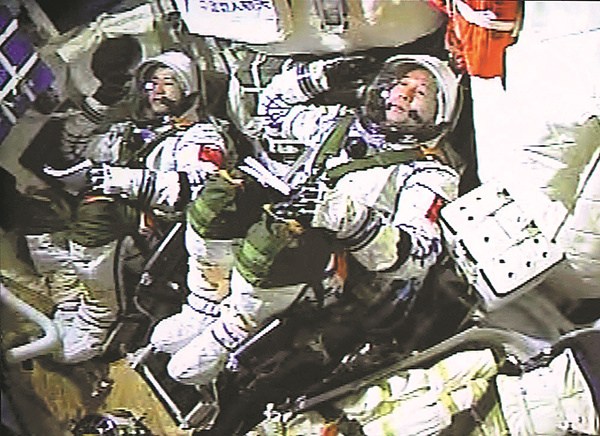
Astronauts Jing Haipeng (right) and Chen Dong salute inside the spacecraft at the moment of launching on Monday. (Photo/Xinhua)
Challenges
China's manned spacecraft Shenzhou XI will stay in space for 33 days, the longest since the country first sent a man into the space in 2003. The mission presents more challenges in protecting astronauts' physical and mental health.
A zero-gravity environment will affect the astronauts' cardiovascular systems, and lead to muscle atrophy, weakened immunity and faster bone loss. These make the spacemen more vulnerable to disease.
To fight the negative impacts, spacemen will use treadmill and chest-expander to practice in the space lab, and wear penguin suits, which produce more tension with its elastic materials, to prevent muscles weakening.
Also, to relieve the stress of astronauts, psychologists, families and colleagues on the ground will communicate with them through video, audio or e-mail.
Practice and mission
Before the mission, the astronauts carried out 33 days of closed training. Except for weightless conditions, every process in the training lab was modeled on that in the space lab.
The eight training subjects were physical fitness, mental fitness, adaption to space environment, weightless protection, rescue and survival skill, rendezvous and docking, medical first-aid, and in-orbit experiment.
Multiple experiments will be carried out when the astronauts enter the Tiangong II space lab. The spacemen will receive in-orbit ultrasonic inspection to test their cardio-pulmonary function, the first of its kind in China's manned space mission. They will also carry out space material experiments, space plant cultivation and in-orbit maintenance of spacecraft.
After the astronauts enter the Tiangong II space lab, experiments will also be carried out to raise the public's science awareness. Three experiments, designed by secondary school students from Hong Kong, will be conducted to help students learn the changes of materials in zero-gravity environment.
Aerospace fashion
To us, "spacesuits" is an all-encompassing word, but to professionally trained astronauts, there are two distinct kinds: on-orbit and on-ground, with ten different sets for all needs.
According to Yang Lizhong, a researcher on spacesuit project, the clothing are designed for practical use in diverse occasions with Chinese aesthetic features.
The on-orbit clothing series clothes are worn by astronauts under temperature suitable for the human body, similar to working suits, shoes, fitness clothing, casual suits, underwears, shoes and sleeping bags, and also spacesuits, aka "penguin suits" to keep muscle trained in space.
The clothing for ground includes training suits, jackets and formal wear.
Many logos are attached on the suits like national flag, logo of the manned space flight project, name, task sign and honor badge.
The honor badge shows how many times an astronaut has been in space with stars.
Accessories like ties, scarves, eye patches and earmuffs are also made for astronauts.


















































